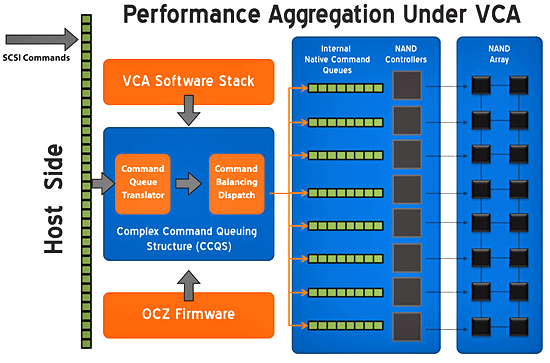OCZ RevoDrive 3 X2 PCIe SSD Performance Preview
These four controllers, two on the daughter card, all connect serially to a main RAID processor on the base board and that's pretty much where the real magic happens. Figuratively at least, because OCZ is holding details of the main RAID processor technology very close to the vest.
Where we scoffed a bit at the previous generation RevoDrive's implementation of a PCI-X to PCIe bridge, bolted up to a Silicon Image PCI-X RAID controller, the RevoDrive 3's design is dramatically more elegant, with fewer chips to get the job done and native PCI Express links on the back-end to talk over the edge connector of the card.


The "magic" we spoke of earlier happens in OCZ's ICT-0183 chip that you can clearly see in the shot above (right). This is what OCZ is calling their "SuperScale Storage Accelerator." If you follow the traces to and from the chip, you'll note very neat and clean serial pairs from the SandForce controllers (SATA links) and on the back side of the chip there are four more pairs running down to the edge connector; these are PCI Express links -- a X4 Gen 2 connection to be specific. Easy right? Not so fast. There's a lot that's going on under the hood of OCZ's ICT-0183 SuperScale processor. Though OCZ would not confirm this, we believe the ICT-0183 is actually based on Indilinx intellectual property and technology that OCZ picked up when they acquired the company back in March of this year. OCZ now also has a large team of 80+ software engineers at their disposal with the Indilinx acquisition.
We're told OCZ's new SuperScale storage processor is a combination of ARM cores, SATA and PCI Express interfaces and of course a bit of bridging in between them. OCZ didn't give us specifics of the processing engines within the SuperScale Accelerator, but they did give us a high-level functional block diagram that shows what's going on with the RevoDrive 3 X2's design implementation.

OCZ's SuperScale Storage Accelerator (left) with VCA 2.0 - System Topology
So what we're looking at here is OCZ's Virtualized Controller Architecture (VCA), as it is implemented in the RevoDrive 3 X2. OCZ's SuperScale processor is the square block on the left, where command queuing and load balancing takes place. As it turns out, the SuperScale Accelerator is much more than just a simple RAID controller and SATA to PCIe bridge. It also supports what OCZ is a calling "Complex Command Queuing Structure" or CCQS. CCQS is a combination of Tagged Command Queuing (TCQ) and Native Command Queuing (NCQ) and along with what OCZ calls their "QBA" or Queue Balancing Algorithm, performance is optimized and workloads are balanced across the drive's RAID stripe with all controllers on the board. OCZ can also bring out up to two SuperScale processors per PCI Express slot/card. However, RAIDing a pair of RevoDrive 3 X2s cards together, though possible, is not recommended. OCZ notes that their upcoming Z-Drive R4, the enterprise class version of the RevoDrive so to speak, will officially support this.
Finally, as we mentioned, OCZ is talking up their VCA technology again with the RevoDrive 3 X2 and they're claiming that this is the second generation of their Virtualized Controller Architecture, that was briefly and quietly introduced a few months back with the Z-Drive R3. Yes, we missed the first iteration too but hey, who's counting, and we'll assume 2.0 is better than the first gen. The Z-Drive R3 didn't make it to market in any great quantity, so it will be interesting to see how VCA 2.0 takes off with the RevoDrive 3 X2 and the upcoming Z-Drive R4.
Regardless, OCZ's also claims the SuperScale Processor on board the RevoDrive 3 X2, supports the VCA 2.0 architecture and offers the following benefits natively.
- TRIM Command and SCSI Unmap for thin provisioning and reduced overhead with garbage collection for performance maintenance.
- Consolidated SMART monitoring of devices in the VCA (Virtualized Controller Architecture).
- User-selectable Data Recovery or Non-Stop modes in the event of drive failure.
- Power fail protection with on-board non-volatile memory for delayed transactions during power loss or system standby.







